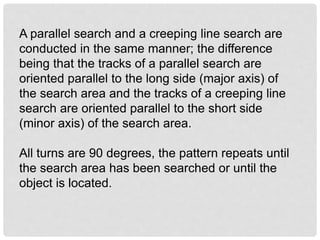NBMTF search patterns
- 2. EXPANDING SQUARE SECTOR SEARCH PARALLEL SEARCH CREEPING LINE SEARCH TRACKLINE SEARCH MAN OVERBOARD PROCEDURES
- 3. EXPANDING SQUARE, SINGLE UNIT (SIERA SIERA)
- 4. A datum buoy is dropped at the best known location of the search object This buoy becomes the center of the search area. The first leg will begin from datum in the direction of drift All turns are to the right 90 degrees. The length of the first leg is one track length; search leg length is increased by one track space on every other leg
- 5. Multiply your track space by the numbers shown in the search pattern below to determine leg length
- 6. A second search is performed by rotating the pattern 45 degrees to the right
- 7. SECTOR SEARCH, SINGLE UNIT (VICTOR SIERA)
- 8. A datum buoy is dropped at the best known location of the search object. This buoy becomes the center (datum) of the search The first leg will begin from datum in the direction of drift All turns are to the right 120 degrees On the third, sixth, and ninth legs steer to the datum buoy Once passed, return to the base course
- 10. In a second search the pattern is rotated 30 degrees to the right
- 11. PARRALLEL SEARCH, SINGLE UNIT (PAPA SIERA) CREEPING LINE SEARCH, SINGLE UNIT (CHARLIE SIERA)
- 12. A parallel search and a creeping line search are conducted in the same manner; the difference being that the tracks of a parallel search are oriented parallel to the long side (major axis) of the search area and the tracks of a creeping line search are oriented parallel to the short side (minor axis) of the search area. All turns are 90 degrees, the pattern repeats until the search area has been searched or until the object is located.
- 14. TRACKLINE, SINGLE UNIT (TANGO SIERA) TRACKLINE, SINGLE UNIT, RETURN (TANGO SIERA ROMEO)
- 15. A trackline search follows the intended track of the missing craft from origin to destination TRACKLINE, SINGLE UNIT (TANGO SIERA)
- 16. TRACKLINE, SINGLE UNIT, RETURN (TANGO SIERA ROMEO) A trackline return search follows a path adjacent to, and off to one side of, the intended track of the missing craft from origin to destination. Once at the missing craftâs intended destination, the search continues back towards the missing craftâs origin, following a path off to the opposite side of the previous search line of the craftâs intended track
- 18. 1. Someone falls in the water 2. The first crewmember to observe the incident calls out âMAN OVERBOARDâ and follows the exclamation with the side from which the event occurred or the person was sighted; then maintains sight of and continuously points to the individual in the water. 3. A crew member throws a ring buoy with strobe light over the side as soon as possible after the alarm is sounded. 4. The vessel operator will perform the following tasks. 5. Turn the boat in the direction indicated by the alarm. 6. Record the position by pressing the man overboard button on the GPS. 7. Sound 5 or more short blast on the horn to alert other boats in the area. 8. Ensure that a floatation device has been deployed MAN OVERBOARD PROCEDURES
- 19. 9. The pointer (usually the first person to see the member go overboard) moves forward near a pilothouse window, locates the overboard and points to the location of the person at all times. The recovery crew member makes preparation for the pickup. 10.The vessel operator makes the recovery approach and briefs the crew on the recovery procedure including which side of the boat the pickup will occur. 11.If additional assistance is required, notify Fire Alarm and notify the Coast Guard and request they broadcast a âPAN PANâ.
- 20. The preferred approached is performed with the bow facing into the greatest force of oncoming resistance (usually the wind but can be seas or current or a combination of the three). âĒ Select the heading that will best ease the approach (usually from downwind). âĒ Make the approach rapidly then slow the boat as it nears the person âĒ Stop the boat with a short backing down burst when the person is next to the recovery area. âĒ Place the transmissions in neutral and have a crewmember make the recovery. âĒ If the boat overruns the person, do not attempt to maneuver closer, swing around and make another approach. RECOVERING A PERSON IN THE WATER




















